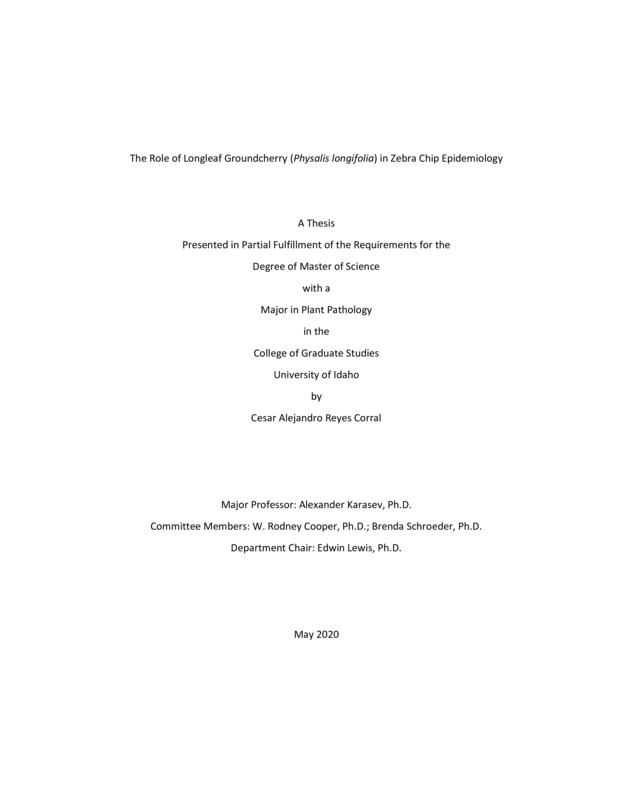The Role of Longleaf Groundcherry (Physalis longifolia) in Zebra Chip Epidemiology
Reyes Corral, Cesar Alejandro. (2020-05). The Role of Longleaf Groundcherry (Physalis longifolia) in Zebra Chip Epidemiology. Theses and Dissertations Collection, University of Idaho Library Digital Collections. https://www.lib.uidaho.edu/digital/etd/items/reyescorral_idaho_0089n_11826.html
- Title:
- The Role of Longleaf Groundcherry (Physalis longifolia) in Zebra Chip Epidemiology
- Author:
- Reyes Corral, Cesar Alejandro
- ORCID:
- 0000-0002-0347-6966
- Date:
- 2020-05
- Keywords:
- Bactericera cockerelli Liberibacter Physalis longifolia potato psyllid
- Program:
- Plant, Soil and Entomological Sciences
- Subject Category:
- Plant pathology; Entomology; Plant sciences
- Abstract:
-
The potato psyllid (Bactericera cockerelli) has been considered a major economic pest of potato (Solanum tuberosum) for over a decade because it is associated with the “psyllid yellows” crop condition and more importantly, it is a vector of the bacterial Zebra Chip pathogen, “Candidatus Liberibacter solanacearum”. This psyllid develops on a wide range of host plants within the Solanaceae and Convolvulaceae and exists as distinct haplotypes that differ in host plant preference and use. In-field management of B. cockerelli using insecticides is not effective because B. cockerelli exists on a whole landscape level and recolonizes fields from non-crop hosts. Perennial weeds provide a ‘bridge’ between winter dormancy and the period when potato and annual weeds are available, which allow large populations of psyllids to accumulate and eventually move into potato fields during the growing season. Previous research on psyllid ecology focused primarily on the role of the perennial host plants, Lycium barbarum (matrimony vine) and Solanum dulcamara (bittersweet nightshade), as sources of psyllids colonizing potato. Both plant species are hosts for B. cockerelli but might not necessarily be the driving force of zebra chip epidemiology in Idaho; L. barbarum does not appear to be a host for “Candidatus Liberibacter solanacearum” while S. dulcamara is largely limited to riparian zones. Physalis longifolia (longleaf groundcherry) is a perennial non-crop solanaceous weedy host native to the East of the Rocky Mountains and found in all counties and states in the Pacific Northwest but has been largely overlooked by researchers as a potential host for B. cockerelli and Liberibacter. This thesis reports results from a series of field, laboratory and greenhouse experiments conducted during 2018 and 2019 to assess the host quality of P. longifolia to B. cockerelli and the zebra chip pathogen, Candidatus Liberibacter solanacearum. This thesis includes three independent chapters that are organized for submission to peer-reviewed journals.
Chapter 1 reports results of B. cockerelli preference and performance assays conducted in laboratory and greenhouse settings. These assays demonstrated that P. longifolia is a better host than potato for B. cockerelli. Psyllids produce more offspring on P. longifolia than on potato and prefer P. longifolia over potato when given a choice. Plant disease susceptibility and insect disease acquisition assays showed that P. longifolia is highly susceptible to Liberibacter. The rhizomes of infected P. longifolia plants successfully overwinter and produce infected plants before potato is available, potentially allowing psyllid colonization and acquisition of the pathogen before potato is available.
Chapter 2 reports results of a field survey conducted during 2018 and 2019 to confirm that B. cockerelli readily colonizes wild stands of P. longifolia. Over 200 psyllids were collected from wild P. longifolia stands in WA and ID, and many of these stands were adjacent to commercial potato fields. Molecular gut content analysis confirmed psyllid movement between P. longifolia and potato.
During 2019, I was approached by a cooperator from Saltillo, Mexico to examine whether B. cockerelli that were infesting a commercial field of Physalis ixocarpa (tomatillo) were infected with Liberibacter, and whether foliar symptoms exhibited by those plants were associated with the pathogen. Results confirmed presence of Liberibacter, and gut content analysis confirmed movement between non-crop solanaceous hosts and tomatillo in Saltillo, Mexico. Results of these surveys are reported in chapter 3.
Overall, the results presented provide evidence that Physalis longifolia is a metapopulation source for B. cockerelli and Liberibacter, which emphasizes the need to further evaluate more Physalis species and solanaceous weeds as hosts for B. cockerelli. Implications of these results could potentially help predict when and where infective psyllids will first colonize potato and develop landscape-level management tactics against B. cockerelli and Liberibacter.
- Description:
- masters, M.S., Plant, Soil and Entomological Sciences -- University of Idaho - College of Graduate Studies, 2020-05
- Major Professor:
- Karasev, Alexander
- Committee:
- Cooper, William R; Schroeder, Brenda
- Defense Date:
- 2020-05
- Identifier:
- ReyesCorral_idaho_0089N_11826
- Type:
- Text
- Format Original:
- Format:
- application/pdf
- Rights:
- In Copyright - Educational Use Permitted. For more information, please contact University of Idaho Library Special Collections and Archives Department at libspec@uidaho.edu.
- Standardized Rights:
- http://rightsstatements.org/vocab/InC-EDU/1.0/

